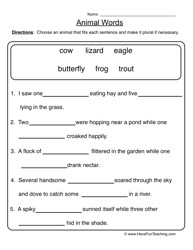Mammal Worksheets for Third Grade
If you're a third-grade teacher or a parent looking for engaging and educational resources to help children learn about mammals, we've got you covered! Worksheets are a fantastic tool for reinforcing concepts and providing independent practice for young learners. With our carefully designed mammal worksheets, children will have the opportunity to explore and discover fascinating facts about different species, their characteristics, habitats, and more.
Table of Images 👆
More 3rd Grade Worksheets
Telling Time Worksheets 3rd GradeTime Worksheets for 3rd Grade
3rd Grade Reading Comprehension Worksheets
Multiplication Worksheets for 3rd Grade
3rd Grade Math Division Worksheets Printable
Short Reading Comprehension Worksheets 3rd Grade
Soil Worksheets for 3rd Grade
Cursive Writing Worksheets for 3rd Grade
3rd Grade Multiplication Properties Worksheet
First Day of School Worksheets 3rd Grade
What is a mammal?
A mammal is a warm-blooded vertebrate animal that has hair or fur, gives live birth, and nurses its young with milk produced by mammary glands. Mammals also have a complex nervous system, with a developed brain and typically exhibit a higher level of social behavior compared to other animals.
What are some common characteristics of mammals?
Common characteristics of mammals include being warm-blooded, having hair or fur covering their bodies, giving birth to live young (with a few exceptions such as monotremes), nursing their young with milk produced by mammary glands, having a four-chambered heart, and typically having a larger brain relative to body size compared to other vertebrates. Mammals also have specialized teeth for different diets and most have a diaphragm for breathing.
How do mammals give birth to their young?
Mammals give birth to their young by delivering live offspring, as opposed to laying eggs like birds or reptiles. The process typically involves the fetus developing inside the mother's body in a special organ called the uterus, where it is nourished through the placenta and umbilical cord. When the offspring is fully developed, the mother goes into labor, which is the process of giving birth. During labor, the mother's muscles contract to push the fetus out of the birth canal, allowing the newborn to enter the world and take its first breath.
What is the purpose of mammal fur or hair?
The primary purpose of mammal fur or hair is to provide insulation and regulate body temperature, as it helps trap heat close to the body. Additionally, fur or hair can provide protection from physical harm, such as cuts or scrapes, and can also be used for sensory purposes, such as detecting changes in the environment or communicating with other animals through displays like fluffing up in defense or attracting a mate.
How do mammals regulate their body temperature?
Mammals regulate their body temperature through a process known as thermoregulation, where they maintain a relatively stable internal temperature despite changes in the external environment. This involves mechanisms such as vasodilation and vasoconstriction of blood vessels, sweating, shivering, seeking shade or warmth, and adjusting metabolic rate. Additionally, mammals can also regulate their body temperature through behavioral changes, such as seeking shelter or changing their activity levels.
What is the importance of mammary glands in mammals?
Mammary glands in mammals are crucial for the nourishment and survival of offspring as they produce milk, which provides essential nutrients and antibodies. This enables newborn mammals to grow, develop, and establish a strong immune system. Additionally, the act of nursing strengthens the bond between mother and offspring, promoting their well-being and ensuring the continuation of the species.
How do mammals obtain oxygen for respiration?
Mammals obtain oxygen for respiration by breathing in air through their lungs. When mammals inhale, air enters their lungs where oxygen is extracted and then transported by the bloodstream to tissues and organs throughout the body. Oxygen is then used in cellular respiration to produce energy for essential metabolic processes.
Why do mammals have different types of teeth?
Mammals have different types of teeth because they are adapted to different tasks related to their diet and feeding habits. For example, incisors are used for cutting and biting, canines are for tearing and piercing, and molars are for grinding and chewing food. This diversity of tooth types allows mammals to efficiently process a wide range of foods, from plants to meat, in their diets.
What are some examples of mammals that live in the ocean?
Some examples of mammals that live in the ocean include dolphins, whales, seals, sea lions, manatees, and sea otters. These marine mammals have adapted to life in aquatic environments and play crucial roles in ocean ecosystems.
How do mammals communicate with each other?
Mammals communicate with each other through a variety of ways including vocalizations, body language, scent marking, and touch. They use vocalizations like sounds, cries, and even songs to convey information such as warning signals, mating calls, or to maintain social bonds. Body language, such as postures, gestures, and facial expressions, can also communicate emotions and intentions. Scent marking helps mammals establish territories, attract mates, and identify individuals, while touch is used for bonding, grooming, and reassurance. Overall, mammals have developed complex communication systems to navigate their social interactions and environments effectively.
Have something to share?
Who is Worksheeto?
At Worksheeto, we are committed to delivering an extensive and varied portfolio of superior quality worksheets, designed to address the educational demands of students, educators, and parents.



































Comments